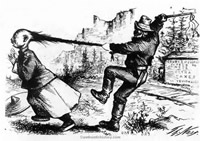 |
|
| |
Issue: The Economy
Hayes called out the federal troops
to keep order during a labor dispute in the
railroad industry. Since there were no antitrust
laws in existence yet, the four major railroad
companies had privately agreed they would all
raise rates and cut wages. He was the first
president to use the military in this way since
Andrew Jackson.
The specie issue from Grant's administration
remained an issue. An 1875 law required that
the government to begin redeeming devalued Civil
War era greenbacks for gold beginning on January
1, 1879. Another law passed in 1878 regulated
the government's use of silver in coins. Hayes
ordered the Treasury Secretary to coin the minimum
amount allowed by the law and the economy did
improve. |
|
|
Issue: Civil Service Reform
Another leftover from the Grant administration
was the issue of civil service reform. Hayes
had placed reforming corruption within the system
at the top of his domestic agenda. His issuance
of an executive order put him directly at odds with Senator Roscoe Conkling, a Republican
from New York, whose power came largely from his control
over being able to appoint people to government positions
working for the Port of New York. Hayes was able to
use his executive power, with the aid of some Senate
Democrats, to replace some of the "Conklingites"
with honest and competent men. This was the first
step toward regaining some power to the executive
branch of government lost to the legislative branch
during the Johnson and Grant administrations.
Issue: Democrat-controlled Congress
During the midterms elections in 1878, the Democratic
Party gained control of the Senate, and maintained
their control of the House of Representatives. They
now began to pass a series of bills designed to limit
the president's ability to use the military to protect
the rights of black voters. They passed a total of
seven such bills, five designed to repeal election
laws and two designed to get around them. Hayes directly
confronted this assault of civil rights with the presidential
veto. The Republicans maintained enough power in Congress
to sustain his vetoes, thereby further enhancing his
presidential power.
|

Anti-Chinese political cartoon |
|
Issue:
Chinese Immigration
Ever since the construction of the first transcontinental
railroad prompted the Central Pacific to recruit
Chinese laborers, anti-Chinese sentiments had
been growing in the West. Congress responded to
these feelings by passing a bill that restricted
Chinese immigration. Hayes vetoed the bill, but
also had Secretary of State William M. Evarts
negotiate a new treaty with China that limited
such immigration. These limits failed to ease
the fears of Euro-Americans, and the issue was
passed down to subsequent administrations.
|
|
Legacy
Despite some successes, Hayes was ultimately unable
to get many of the reforms he was after as president.
The President's humanitarian outlook, especially
as applied to minorities, did not translate into
meaningful gains for Blacks or Indians. This was largely due
to limitations imposed on him by the Democrat-controlled
congress. Hayes declined to run for a second term. Once
a civilian, he worked for reform in the other ways as
an exemplary retired president. The death of Lincoln,
the impeachment of Johnson, and the failures of Grant
had left the presidency at the weakest state ever when
Hayes took office under controversial circumstances.
A decent and principled man, Rutherford B. Hayes helped
to restore prestige to the office and to heal the deep
wounds left by the Civil War. |
| |
|

|
|
|
|
|
|
|
|
|
|

